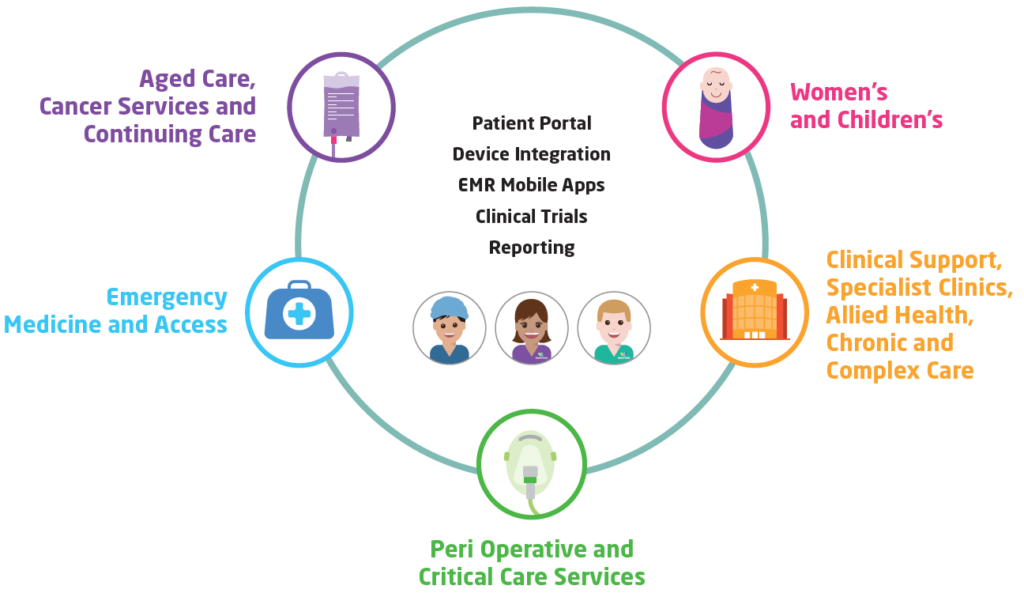Vision, Timeline and Scope
What is our Vision for the Electronic Medical Record (EMR) Phase 2?
A complete and well-integrated EMR solution that will deliver safe and effective patient care, reduced clinical risk and streamlined workflows providing staff and patient satisfaction and better patient care.
Why is Western Health implementing Electronic Medical Record (EMR) Phase 2?
The goal for EMR Phase 2 is to achieve a complete and integrated EMR solution to give clinicians easier access to information for the whole patient journey.
The removal of gaps between clinical departments, and the storage of patient data in a single repository, means we will move closer to a single patient record for each patient across the Western Health EMR sites, streamlining the clinician and patient experience.
Through the delivery of EMR Phase 2, and associated digital health projects, we will deliver on our vision of Connecting Best Care.
Due to the considerable scale of this project it has been divided into two phases, Phase 2.1 and Phase 2.2.
EMR Phase 2.1 is focused on extending Western Health’s EMR to clinical areas that are currently needing to swap between electronic systems or between electronic and paper processes. Our goal is to remove these barriers to care between clinical departments in order to achieve a seamless electronic patient journey.
EMR Phase 2.1 will enhance access to health care information for both patients and health care professionals.
Patients will be more connected to important information about their care and treatment through the introduction of a Patient Portal. Through this a patient will be able to view health care details such as upcoming appointments, test results and patient education.
Health care professionals will have streamlined access to healthcare information for the whole patient journey. In addition to a reduced need to swap between electronic systems or between electronic and paper processes, some areas will be able to access the EMR from a hand held portable device (this is known as EMR Mobile Apps).
EMR Phase 2.2 focuses on bringing together the clinical and administrative workflow by replacing iPM (the existing patient administration system). Further scope is currently being assessed.
EMR Phase 2.1 Timeline
The EMR Phase 2.1 project commenced in February 2021 with a successful Go-Live of the majority of the EMR Phase 2.1 functionality in July-August 2023.
The EMR Phase 2.1 maternity rollout is continuing, and further EMR Phase 2.1 functionality will be implemented in 2024 including:
- Western Health Patient Portal
- EMR mobile apps
- New ICU dashboard
- Mechanical restraints
Which Western Health sites are involved in EMR Phase 2.1?
EMR Phase 2.1 was implemented across the Western Health sites in which EMR Phase 1 was implemented in late 2018, which included:
- Footscray Hospital
- Sunbury Day Hospital
- Sunshine Hospital
- Williamstown Hospital
- Drug Health Services including Westside Lodge
A separate project is underway to extend the Digital Health functionality currently used at the above sites to the Bacchus Marsh and Melton sites. Please click here to visit the Bacchus Marsh Melton Digital Health Transition page of this site.
EMR Phase 2.1 scope

Women’s and Children’s and Newborn Services
EMR Phase 2.1 also involves the connection of various biomedical devices to the EMR so health care information can be transmitted electronically directly into the patient’s record. The biomedical devices that have been integrated with the EMR are:
- Welch Allyn Connex Spot Monitors
- Philips IntelliVue Patient monitoring – used in ED, ICU / NICU
- GE Carescape Patient Monitoring – used in Perioperative areas
- Anaesthesetic machines – used in Theatres
The following biomedical devices will also be integrated with the EMR in the coming months as part of the EMR Phase 2.1 project
- BD Alaris Infusion Pumps – ICU / NICU
- Mortara Eli 280 / 380 ECG Carts
- Philips Fetal Monitors – MAC and Birthing
EMR Phase 2.1 will see the completion of statutory reporting (such as Births and Deaths) through the EMR and additional features used to support research. The EMR provides greater visibility to staff when a patient is participating in research trial and allows documentation to occur. An additional feature is to be able to identify inclusion/exclusion criteria to assist in identifying suitable patients eligible for the research trials.
Finally, EMR Phase 2.1 also involves the rollout of Mobility or EMR Mobile Apps to provide some clinical areas with EMR access on a hand held device, and the creation of a Patient Portal so patients can view health care details such as their test results and their appointments.
By supporting our patients with easier access to their health information we can help to improve, promote and protect the health of our community.
Why are digital systems being replaced with the Cerner EMR system?
As of early 2023 Western Health’s clinical areas were using upwards of 25 different digital systems. World-wide research, and indeed our own experience here at Western Health – including feedback from our own staff, has shown complex integration issues when a health service is managing a wide range of digital systems from different vendors. This can result in downtimes and a lack of ability to access all information when required. There also often isn’t a way to “link” all of the patient information together, resulting in duplication of effort, inefficiencies and many records remaining on paper, creating a difficult to navigate hybrid mix of paper and multiple disconnected digital records for one patient.
Moving to a single electronic patient record (the Cerner EMR) will result in a reduction of the number of systems used on a day to day basis and integrate the whole patient journey, making it easier for clinicians to access the full picture of a patient’s history facilitating faster, safer care.
